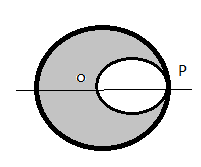
A transparent sphere of radius R has a cavity of radius $\dfrac{R}{2}$ as shown in Fig. The refractive index of the sphere if a parallel beam of light falling on the left surface focuses at point P is $\dfrac{3+\sqrt{5}}{x}$. Find out the value of X?

Answer
219.3k+ views
Hint:We have to find the refractive index of the sphere if a parallel beam of light falling on the left surface focuses on a point. It is given that this transparent sphere of radius R has a cavity of radius $\dfrac{R}{2}$ . Using the equation connecting image distance, refractive index and radius we can find the value of x.
Formula used:
Let refractive index be μ and v be image distance and if the light is falling parallel then we have the equation as:
$\dfrac{\mu }{v}-\dfrac{1}{\infty }=\dfrac{\mu }{\mu -1}$
Complete step by step solution:
We have a transparent sphere of radius R and it has a cavity with radius $\dfrac{R}{2}$. Refractive index of the sphere is given as $\dfrac{3+\sqrt{5}}{x}$. This refractive index is measured when a parallel beam of light falling on the left surface focuses at point P. All conditions are given and we have to find the value of x. That is, we have to find a refractive index. When a parallel beam of light is falling on the left surface, then object distance will be infinity.
Let refractive index be μ and v be image distance and if the light is falling parallel then we have the equation as:
$\dfrac{\mu }{v}-\dfrac{1}{\infty }=\dfrac{\mu }{\mu -1}$
That is,
$v=\dfrac{\mu R}{\mu -1}$
For finding object distance at second boundary, we have:
$u=\dfrac{\mu R}{\mu -1}-R=\dfrac{R}{\mu -1}$
Hence the equation for refraction at second boundary is
$\dfrac{\mu }{-u}+\dfrac{1}{R}=\dfrac{1-\mu }{\dfrac{R}{2}}$
On substituting the values, we get:
$\dfrac{1}{R}=\dfrac{2(1-\mu )}{R}+\dfrac{\mu }{\dfrac{R}{\mu -1}}$
On further solving we get a quadratic equation in terms of refractive index (μ) as:
${{\mu }^{2}}-3\mu +1=0$
On solving this quadratic equation, we get refractive index as:
Refractive index, $\mu =\dfrac{3+\sqrt{5}}{2}$
Therefore, the answer is $x=2$
Notes: Here on solving quadratic equations we get two values for the refractive index. But the refractive index is already given, we only have to find the denominator so we ignore another value. In this question we consider refraction at two surfaces.
Formula used:
Let refractive index be μ and v be image distance and if the light is falling parallel then we have the equation as:
$\dfrac{\mu }{v}-\dfrac{1}{\infty }=\dfrac{\mu }{\mu -1}$
Complete step by step solution:
We have a transparent sphere of radius R and it has a cavity with radius $\dfrac{R}{2}$. Refractive index of the sphere is given as $\dfrac{3+\sqrt{5}}{x}$. This refractive index is measured when a parallel beam of light falling on the left surface focuses at point P. All conditions are given and we have to find the value of x. That is, we have to find a refractive index. When a parallel beam of light is falling on the left surface, then object distance will be infinity.
Let refractive index be μ and v be image distance and if the light is falling parallel then we have the equation as:
$\dfrac{\mu }{v}-\dfrac{1}{\infty }=\dfrac{\mu }{\mu -1}$
That is,
$v=\dfrac{\mu R}{\mu -1}$
For finding object distance at second boundary, we have:
$u=\dfrac{\mu R}{\mu -1}-R=\dfrac{R}{\mu -1}$
Hence the equation for refraction at second boundary is
$\dfrac{\mu }{-u}+\dfrac{1}{R}=\dfrac{1-\mu }{\dfrac{R}{2}}$
On substituting the values, we get:
$\dfrac{1}{R}=\dfrac{2(1-\mu )}{R}+\dfrac{\mu }{\dfrac{R}{\mu -1}}$
On further solving we get a quadratic equation in terms of refractive index (μ) as:
${{\mu }^{2}}-3\mu +1=0$
On solving this quadratic equation, we get refractive index as:
Refractive index, $\mu =\dfrac{3+\sqrt{5}}{2}$
Therefore, the answer is $x=2$
Notes: Here on solving quadratic equations we get two values for the refractive index. But the refractive index is already given, we only have to find the denominator so we ignore another value. In this question we consider refraction at two surfaces.
Recently Updated Pages
A square frame of side 10 cm and a long straight wire class 12 physics JEE_Main

The work done in slowly moving an electron of charge class 12 physics JEE_Main

Two identical charged spheres suspended from a common class 12 physics JEE_Main

According to Bohrs theory the timeaveraged magnetic class 12 physics JEE_Main

ill in the blanks Pure tungsten has A Low resistivity class 12 physics JEE_Main

The value of the resistor RS needed in the DC voltage class 12 physics JEE_Main

Trending doubts
JEE Main 2026: Application Form Open, Exam Dates, Syllabus, Eligibility & Question Papers

Understanding Uniform Acceleration in Physics

Derivation of Equation of Trajectory Explained for Students

Hybridisation in Chemistry – Concept, Types & Applications

Understanding the Angle of Deviation in a Prism

Understanding Collisions: Types and Examples for Students

Other Pages
JEE Advanced Marks vs Ranks 2025: Understanding Category-wise Qualifying Marks and Previous Year Cut-offs

Understanding Atomic Structure for Beginners

How to Convert a Galvanometer into an Ammeter or Voltmeter

Understanding Centrifugal Force in Physics

JEE Main Marking Scheme 2026- Paper-Wise Marks Distribution and Negative Marking Details

Degree of Dissociation: Meaning, Formula, Calculation & Uses




